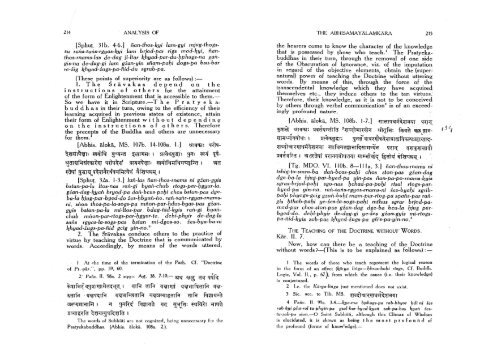ABHISAMAYALAMKARA
ABHISAMAYALAMKARA
ABHISAMAYALAMKARA
Create successful ePaper yourself
Turn your PDF publications into a flip-book with our unique Google optimized e-Paper software.
214 ANALYSIS OF<br />
[Sphut. 3!b. 4-6.] nan-thos-kyi lam-gyi mjug-thogssu<br />
rahs-sahs-rgyas-fyyi lam brjod-par rigs mod-kyi, nantho$~tnams4as<br />
de-dag ji-ltar khyad-par-du-hphags-na gahgis-na<br />
de-dtxg-gi lam gzan-yin snam-pahi dogs-pa bsu-bar<br />
re-zig fyhyad-zugs-pa-nid-dti sgrub-pa.<br />
(These points of superiority are as follows):—<br />
I. The ^ravakas depend on the<br />
instructions of others for the attainment<br />
of the form of Enlightenment that is accessible to thern.—<br />
So we have it in Scripture.—T he Pratyekab<br />
u d d h a s in their turn, owing to the efficiency of their<br />
learning acquired in previous states of existence, attain<br />
their form of Enlightenment without depending<br />
on the instructions of others. Therefore<br />
the precepts of the Buddha and others are 1 unnecessary<br />
for them. 1<br />
[Abhis. aloka, MS. 107b. 14-lO8a. 1.]<br />
THE <strong>ABHISAMAYALAMKARA</strong> 215<br />
the hearers come to know the character of the 1 knowledge<br />
that is possessed by those who teach. 1 The Pratyekabuddhas<br />
in their turn, through the removal of one side<br />
of the Obscuration of Ignorance, viz. of the imputation<br />
in regard of the objective elements, obtain the (supernatural)<br />
power of teaching the Doctrine without uttering<br />
words. By means of this, through the force of the<br />
transcendental knowledge which they have acquired<br />
themselves etc., they induce others to the teo virtues.<br />
Therefore, their knowledge, as it is not to be conceived<br />
by others through verbal communication 2 is of an exceedingly<br />
profound nature.<br />
[Abhis. aloka, MS. 108b. 1-7.]<br />
[Sphut. 32a. \-3.} luh-las nati-thos-rnamsni gzan-gyis<br />
bstan-pa-la Itos-nas rah-gi byan-chub rtogs-par-hgyur-la.<br />
gzan-dag-i^yah bryod-pa dart-bcas-pahi chos bstan-pas dge~<br />
ba-la hjug-pm-byed-do zed-hbyun-ho. ran-$an-rgyas-rnamsni.<br />
short thospa~la~sogs~pa mnon-par-hdus-byas-pas gzangyis<br />
bstan~pa4a mi-ltos-par bdag-hid-kyis rah-gi byahchub<br />
mnon-par-rtogs-par-hgyur-te. dehi-phyir de-dag-la<br />
sans rgyas-la-sogs-pas bsian mi-dgos^-so. zes-bya-ba-ni<br />
fyhyad-zugs-pa-nid gcig yin-no. 2<br />
2. The ^ravakas conduce others to the practice of<br />
virtue by teaching the Doctrine that is communicated by<br />
words. Accordingly, by means of the words uttered,<br />
1 At the time of the termination of the Path. Cf. "Doctrine<br />
of Pr.-pir.", pp. 59, 60.<br />
2 Paiic. II. 98a. 2 sqq= Ast 38. 7-10.—<br />
The words of Subhuti are not cognized, being unnecessary fcr the<br />
Pratyekabuddhas. (Abhis. aloka. I08a. 2.).<br />
[Tg. MDO. VI. flOb. 8—Ilia, 3] nan-thos-rnams ni<br />
tshig-iu-smra-ba dan-bcas-pahi chos ston-pas gzan-dag<br />
dge-ba-la hjug-par-byed-pa yin-pas nanr-pa-po-rnams-kyis<br />
sgras-brjod-pahi sgo-nas hchad-pa-pohi rtsal rtogs-parbyed-pa<br />
yin-na. rah-sahs-rgyasirnams-ni ses^byah,i sgribpahi<br />
phycgs-gcig gzun-bahi rnam-par-rtog-pa spans-pas rangis<br />
hthob-pahi ye-ses-la-sogs-pahi mthus sgrar brjod-pamed-par<br />
chos-ston-pas gzan-dag dge-ba bcu-la hjag parbyed-do.<br />
dehi-phyir de-dag-gi ye-ses gzan-gyis mi-rtogspa-nid-kyis<br />
zab-pas k.hyad-£ugs-pa gws-pa-yin-no. 4<br />
THE TEACHING OF THE DOCTRINE WITHOUT WORDS,<br />
Kar. II. 7.<br />
Now, how can there be a teaching of the Doctrine<br />
without words—(This is to be explained as follows): —<br />
1 The words of those who teach represent the logical reason<br />
in the form of an effect (hjarya linga = hbras~buhi riags, Cf. Buddh.<br />
Logic, Vol. II., p. 67.J, from which the cause (i.e. their knowledge)<br />
is conjectured.<br />
2 I.e. the Karya-linga just mentioned does not exist.<br />
3 Sic. ace. to Tib. MS.<br />
Sic.<br />
4 Pane. II. 99a. 3-4.—kye-rna hphags-pa rab-kbyor hdi ni ses<br />
rab-kytpha-rol-ta-phyin-pa gsal-bar-byed-kyon zab-pa-bas hyan sesiu~zab~pa<br />
ston.—O Saint Subhuti, although this Climax of Wisdom<br />
is elucidated, ii is shown as being the most profound of<br />
the profound (forms of know^dge).—












![Long Discourses of the Buddha [Digha Nikaya]](https://img.yumpu.com/32792419/1/164x260/long-discourses-of-the-buddha-digha-nikaya.jpg?quality=85)


